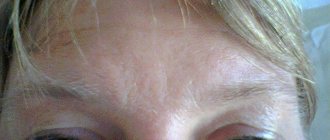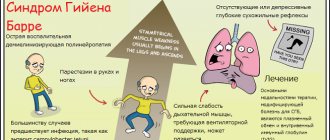An illness such as restless legs syndrome can be treated at home. But what kind of attack is this? Restless legs syndrome is a pathology that causes many problems. The sensation of “crawling goosebumps,” burning, tingling, and twitching of the legs occurs in the evening, intensifies at night and only goes away in the morning.
A person cannot sleep due to unpleasant sensations, insomnia and exhaustion of the nervous system appear. At the same time, not everyone goes to the doctor: there seem to be no complaints, but it is impossible to sleep peacefully. The problem is that doctors do not always make the correct diagnosis and prescribe treatment that cannot help.
But with RLS, you can completely get rid of the symptoms and find restful sleep: there are drugs that provide relief already on the first day of use. Although, with a mild course of the disease, you can try traditional methods first - for some this is enough.
Causes of restless legs syndrome
Since the exact pathogenesis of the disorder is unknown, doctors today are unable to explain its nature. At the same time, it is customary to distinguish between two main manifestations of the problem, the division of which is based on the origin of the RLS:
- Idiopathic restless legs syndrome is a primary process, the cause of which is unknown. Moreover, more than 50% of precedents for identifying this disorder belong specifically to this group. Familial cases of the disease have also been confirmed, which are diagnosed in 40–80% of patients. Presumably, this pattern is associated with genetic changes, namely, with defects in individual sections of chromosomes. Doctors are inclined to believe that the disorder is multifactorial, that is, the need for exposure to environmental factors and the presence of a predisposition to the development of the disease.
- Symptomatic restless legs syndrome is associated with other ailments, which are the main reason for its formation. Failures that occur both with age and under the influence of chronic processes provoke metabolic disorders, leading to tremors of the limbs. It is one of the main signs of this movement disorder. Failures in physiological innervation occur with vegetative-vascular dystonia (VSD), lack of microelements, and renal dysfunction. Uremia presumably plays a key role in the pathogenesis, which is associated with a high percentage of patients on dialysis who are diagnosed with muscle dysfunction. A certain cascade of reactions provokes the occurrence of restless legs syndrome during pregnancy. All these reasons can lead to RLS.
There are two main theories that explain the nature of the clinical manifestations of the problem. The first is based on the participation of iron in the conduction of nerve impulses. Low concentrations of ferritin in the blood of patients are associated with greater severity of symptoms and poor prognosis. This assumption is also confirmed by visual methods of studying the brain, such as magnetic resonance imaging and polysomnography. An autopsy of people with severe manifestations of RLS revealed a decrease in the level of iron in neuromelanin, as well as an increase in the amount of a protein that regulates the transport and metabolism of this microelement. The difficulty of using these indicators in the prognostic assessment of patients is that their level in peripheral blood does not reflect its intracellular concentration, which is of key importance. At the same time, there are studies proving that the blood-brain barrier is a kind of iron reservoir that is actively used by brain neurons.
The second theory is based on dysfunction of dopaminergic receptors. The neurotransmitter that controls impulse transmission plays an important role in the proper functioning of skeletal muscles. Although the exact cascade of reactions in RLS is unknown, this assumption is currently one of the main ones. It is based on a significant improvement in the condition of patients when using drugs from the group of dopaminomimetics.
Causes of the disease
Unpleasant sensations often make themselves felt when the person’s body is stationary or lying down. An interesting fact is that moving the legs alleviates the patient’s condition, but this lasts for several minutes, and then everything starts all over again.
The results of the treatment showed that it is possible to combat this disease in various ways. It all depends on the degree of complexity of the disease. Medical treatment is practiced, using folk remedies, as well as therapeutic, simple exercises.
The causes of restless legs syndrome have not been precisely established to this day. But research results have shown that the appearance of a painful illness may be associated with hypertension, disorders of the cardiovascular system, and spinal diseases.
Unpleasant sensations in the lower and even upper extremities occur spontaneously. In this case, doctors talk about the primary manifestation of the disease or idiopathic.
This disease is considered hereditary and occurs in people who are related to each other. Therefore, when restless leg syndrome is detected in a child, doctors attribute it to heredity.
There is a secondary form of the disease that occurs due to various disorders in the human body. Most often this concerns failures of the central nervous system.
The disease is observed during:
- pregnancy;
- renal failure;
- iron deficiency anemia (lack of iron in the body);
- diabetes mellitus;
- spinal cord damage;
- abuse of alcohol, caffeine;
- use of medications (neuroleptics, antiemetics, anticonvulsants, antihistamines);
- deficiency of vitamin B2, folic acid;
- gastric resection;
- rheumatoid arthritis;
- chronic lung disease;
- severe heart failure.
It is important to determine the primary and secondary degrees of the disease. The treatment tactics depend on it, which differs in idiopathic and symptomatic syndromes.
Main symptoms
Although medicine does not know exactly the pathogenesis of the disease, its clinical picture only confirms the assumption of the neurological origin of the disease. Signs of RLS are directly related to impaired innervation of the muscles of the limbs. Hands are rarely involved in the process only due to less load and the absence of such a pronounced predisposition to stagnation. There are several main symptoms of restless legs syndrome. However, most often they occur in a supine position, during sleep or before it:
- The limbs begin to buzz. Patients complain of discomfort, but there is no pain. Exercises and massage help get rid of this problem, so people try to walk around and stretch their legs. The condition is alleviated by increasing the activity of blood flow.
- The sensitivity of the lower extremities is impaired. A tingling sensation appears, the legs seem to become cold, there is an itching sensation and a desire to run.
- Muscle tremors are a common symptom. It manifests itself as twitching fingers, and sometimes the entire foot is involved in the process. The lower legs may also be affected, but this is less common.
More often, clinical manifestations are recorded in the late evening or at night. This makes patients irritable, distracted and reduces their performance because it interferes with normal rest. Some people develop insomnia because it takes a long time for muscle tremors and discomfort to calm down.
Gymnastics to relieve symptoms
Every day you need to perform exercises that will alleviate the condition and relieve symptoms of the disease:
- Squats.
- Calf muscle stretching exercises.
- Run or walk shortly before bed.
- Leg bends.
- Cycling or exercise on a stationary bike.
These exercises are simple and accessible to everyone, and the effect is very good. Patients note positive changes after they began to exercise.
There are no specific measures to prevent restless legs syndrome. It is enough to lead a healthy lifestyle, stop smoking, reduce caffeine consumption, exercise regularly and watch your diet. Include foods rich in iron, magnesium and potassium in your diet.
And if symptoms of the disease appear, be sure to consult a doctor. In some cases, restless legs syndrome has an underlying cause, then your task is to cure the underlying disease. And it’s up to you to decide which treatment method to choose – folk remedies or pharmaceutical drugs.
Diagnosis of the disease
To date, there are no methods to detect or accurately confirm the disease. If you suspect restless legs syndrome, you will need to see a neurologist who will take an anamnesis and conduct a thorough examination of the patient. With the secondary development of a movement disorder, hematological tests will be needed, as well as polysomnography, which allows you to record brain activity during sleep. Diagnostics includes x-ray examination, as well as photos of the central nervous system using magnetic resonance or computed tomography to exclude pathological changes. Based on the results of the examinations, an individual plan to combat the disorder is drawn up.
How to prepare for bed correctly?
The big problems with restless legs syndrome are insomnia, fatigue and chronic stress. That's why it's important to establish bedtime rituals and follow them every day. They will help relieve stress and help you fall asleep faster. Follow these rules:
- Get enough physical activity during the day, including walking.
- Take a hot bath. You can also make contrast baths, ending with hot water.
- Do foot massage and rubbing.
- Two hours before bedtime, stop using gadgets and instead read a book.
- Dinner should be light, no snacks before bed! Avoid tea and coffee.
Treatment for RLS
Therapy for the disease depends on the etiology of its formation. If the syndrome occurs against the background of other chronic systemic problems, then it is necessary to influence the cause. When restless legs syndrome occurs primarily and is idiopathic, treatment is carried out at home, and the justification for drug support in each case is determined individually.
Drugs
When fighting RLS, doctors try not to use potent drugs, as this can negatively affect the patient’s general condition. Herbal preparations based on valerian and motherwort are widely used. In severe cases, anticonvulsants and dopaminergic medications such as Levodopa are used. The effectiveness of the latter once again proves the neurological origin of the disorder. Sedatives are also actively used to restore natural sleep, which is disrupted by restless legs syndrome. When the patient's condition is aggravated by depression, appropriate medications are used.
If a patient has a deficiency of vitamins and microelements, in addition to a special diet, synthetic analogues of these substances in the form of tablets are also prescribed. Iron, magnesium and folic acid supplements help normalize neuromuscular transmission and mitigate the manifestations of RLS. If the syndrome is associated with congestion, ointments that activate venous circulation, such as Troxerutin, are used. Drugs that help thin the blood are also effective, for example, Aspirin, which also has an analgesic effect, as well as medications for removing excess fluid, which include Diacarb.
Folk remedies
Home treatment has good reviews for restless legs syndrome. This is due to the great importance of diets and regimens in the fight against this disorder. The most effective in maintaining good health in patients with RLS are the following recipes:
- Hawthorn infusion helps fight spasms and anxiety. You will need to pour a teaspoon of dried plant flowers with a glass of boiling water, leave for 2-3 hours, then take the drink 2-3 times a day.
- Melissa also helps to cope with the manifestations of the disease. Moreover, it can be taken either as an infusion, which requires only half a teaspoon per glass of boiling water, or used for foot baths at night.
It is important to maintain sleep hygiene. The bedroom needs to be well ventilated. If patients go to rest at approximately the same time, they feel a noticeable improvement, which means that adherence to the regime has a beneficial effect on the course of the disease. A walk in the fresh air before bed also helps combat muscle tremors and discomfort.
Gymnastics
Exercise plays a leading role in the fight against restless leg syndrome. It is important not to overload the lower limbs, as this will only aggravate the situation. Doctors recommend doing gymnastics based on stretching, as it has a beneficial effect on the functional ability of the muscles. You can do it both during the day and before bed. Yoga is a good helper in the treatment of restless leg syndrome. Various asanas allow you to keep your body in good shape without putting too much strain on the muscles of the lower extremities. Regular walking is also useful, for which no special conditions are required.
Prognosis and prevention
The outcome of the disease depends on the cause of its occurrence and the adequacy of the therapy. In cases of idiopathic RLS, 30% of patients experience long-term remission. If other chronic diseases are identified that could provoke the disorder, the prognosis depends on the response to their treatment.
Prevention comes down to maintaining a mobile and active lifestyle, following the general rules of a healthy diet and timely diagnosis of systemic ailments that can cause movement disorders.











